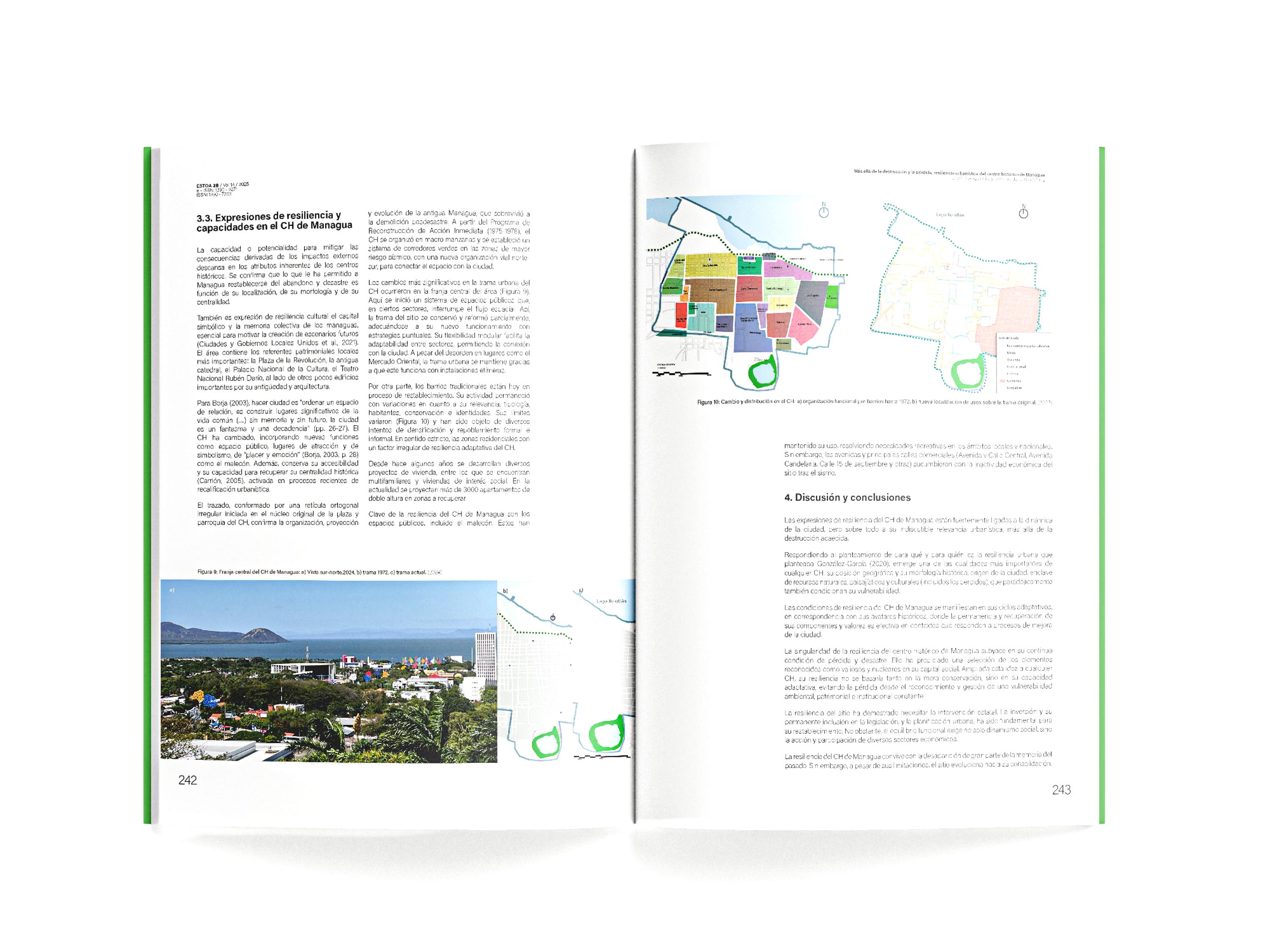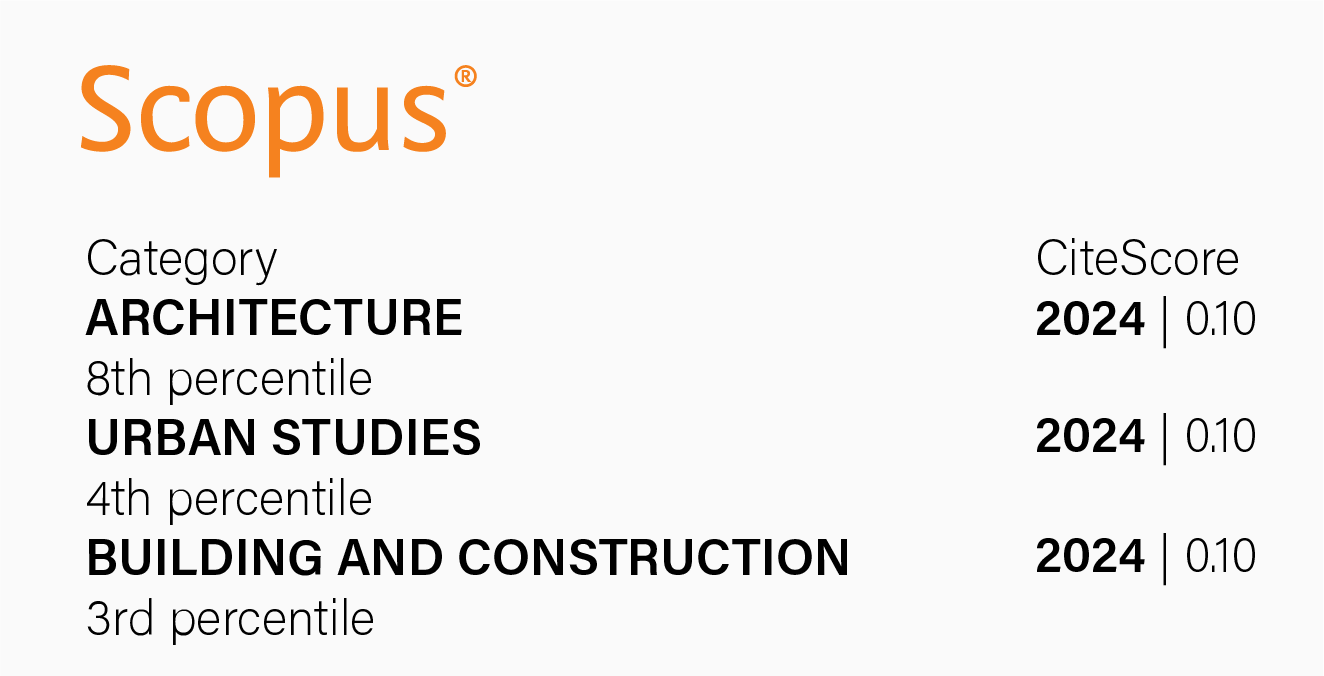Beyond destruction and loss, urban resilience of the Historic Center of Managua
DOI:
https://doi.org/10.18537/est.v014.n028.a16Keywords:
historic center, urban resilience, cities of Hispanic America, Managua, natural hazardsAbstract
This article analyzes the factors that validate the resilient condition of the historic center of the city of Managua, a space that has suffered extraordinary events of destruction, but retains relevance in its urban system. With a synthetic narration of the facts, the conditions of a space of resistance in the face of adversity, capable of overcoming great impacts of natural and anthropic origin, are approached in an integrated manner. As expressions of this resilience, factors of location, morphology and management are identified that sustain the functional and symbolic capacity of the historic center, despite the loss of historic buildings and the disappearance of the scenography of the colonial heritage. To account for the potential of overcoming a history of destruction, abandonment and loss of this space, an eco-urban model of resilience is proposed, interpreted through adaptive cycles. In the background remains the hypothesis that historic centers are not only capable of overcoming adversities, but also play a vital role in the resilience of the urban system to which they belong.
Downloads
References
Alcaldía de Managua. (1994). Plan Maestro para el Área Central de Managua. ALMA.
Álvarez-Mora, A. (2006). El Mito del Centro Histórico, el espacio de prestigio y la desigualdad. Universidad de Valladolid, Instituto Universitario de Urbanística, Universidad Iberoamericana Puebla.
Banco Interamericano de Desarrollo. (2014). Plan de Acción Managua Sostenible. BID
Biblioteca del Congreso de los Estados Unidos. (s.f). Mapa de la república de Nicaragua. https://www.loc.gov/resource/g4850.ct000429/?r=-0.252,-0.015,1.415,0.652,0
Borja, J. (2003). La Ciudad Conquistada. Alianza Editorial.
Carbonara, G., y Magar, V. (2023). Los centros históricos entre la política, el urbanismo y la restauración. Conversaciones... con Fernando Chueca Goitia y Carlos Flores Marini, (11), 124–134. https://www.revistas.inah.gob.mx/index.php/conversaciones/article/view/19046
Carrión, F. (2005). El centro histórico como proyecto y objeto de deseo. Eure, 31(93), 89-100. http://dx.doi.org/10.4067/S0250-71612005009300006
Ciudades y Gobiernos Locales Unidos, Programa de las Naciones Unidas para los Asentamientos Humanos y Oficina de las Naciones Unidas para la Reducción del Riesgo de Desastres (2021). Módulo II de Aprendizaje sobre Resiliencia: Estrategias y Acciones. CGLU, UNDRR y ONU-Hábitat. https://urbanresiliencehub.org/publications/
Díez-Bermejo, A., Hernández -Aja, A., y Sanz- Fernández, A. (2022). Resiliencia urbana: discurso e institucionalización de un concepto. CIUDADES, 25, 1-18. https://doi.org/10.24197/ciudades.25.2022.1-18
Gaitán, M. (20 de junio, 2021). 90 aniversario del terremoto que destruyó Managua en 1931 (cuatro filmes que han hecho historia). Revista centroamericana de cultura y opinión. https://casiliteral.com/la-ventana-discreta/90-aniversario-del-terremoto-que-destruyo-managua-en-1931-cuatro-filmes-que-han-hecho-historia/
González-García, I. (2020). Resiliencia Urbana, ¿para qué o contra quién? en A. Hernández-Aja, G. Sánchez-Toscano, A. Sánz – Fernández (Eds.), Resiliencia funcional de las áreas urbanas. El caso del Área Urbana de Madrid (pp. 31-35). Universidad Politécnica de Madrid.
Hernández-Aja, A., Aparicio-Mourelo, Á., Gómez, M., González, I., Córdoba-Hernández, R., Díez-Bermejo, A., Sánchez-Toscano, G., Sánz-Fernández, A., Álvarez del Valle, L., Carmona, Carpio-Pinedo, J., Gómez-Giménez, J., Jiménez-Romera, C., Morán-Alonso, N. y Picardo-Costales, L. (2020). Resiliencia funcional de las áreas urbanas. El caso del Área Urbana de Madrid. Universidad Politécnica de Madrid.
Historia de Managua. (5 de agosto, 2020). [Limpieza de Managua. Finales de los 70]. [Publicación foto]. Facebook. https://www.facebook.com/HistoriadeManagua/photos/pb.100067834195844.-2207520000/311231943623153/?type=3&locale=cx_PH
Holling, C. & Gunderson, L. (2002). Resilience and Adaptative Cycles en L., Gunderson, & C. Holling (Eds.), Panarchy: understanding transformations in human and natural systems (pp. 25- 62). Island Press.
Holling, C. S. (1996). Engineering Resilience versus Ecological Resilience en P. Schulze (Ed.), Engineering Within Ecological Constraints. Nacional Academy os Sciences.
Instituto Nicaragüense de Estudios Territoriales. (2002). Actualización de Fallas Geológicas de Managua. INETER. https://sjnavarro.files.wordpress.com/2008/09/fallas-geologicas-managua.pdf
Jordán-Salinas, J., Pérez-Eguíluz, V., y De las Rivas-Sanz, J. L. (2020). Paisaje Urbano Histórico: aprendiendo de una ciudad paisaje, Segovia. EURE, 46(137), 87-110. http://dx.doi.org/10.4067/S0250-71612020000100087
Lampis, A. (2023). Resiliencia y ciudad neoliberal: una genealogía sobre América Latina. Iconos, 27(1), 13-34. https://doi.org/10.17141/iconos.75.2023.5499
López-Irías, N. y Suárez-Bonilla, B. (2022). En retrospectiva; aportes de los instrumentos de planificación urbana en la ciudad de Managua, Nicaragua. Arquitectura +, 7(13), 79-101. https://doi.org/10.5377/arquitectura.v7i13.14491
Mesa Nacional de Gestión de Riesgo. (31 de marzo, 2020). El 31 de marzo de 1931. https://mngrnicaragua.org/el-31-de-marzo-de-1931-2/
Moreno, O. (2021). El paisaje como infraestructura para la resiliencia urbana frente a desastres: el caso de los Parques de Mitigación en la costa centro-sur de Chile post tsunami 2010. Cuadernos de investigación urbanística, (139), 1-111. https://doi.org/10.20868/ciur.2021.139.4778
Murillo, C., Calderón, A., Icaza, H., y Sánchez L. (2023). El desarrollo urbano sostenible en América Latina. Universidad, Ciencia y Tecnología, 27(119), 116-126. https://doi.org/10.47460/uct.v27i119.713
Musset, A. (2011). Ciudades nómadas del Nuevo Mundo. Fondo de Cultura Económica.
Naciones Unidas, Consejo Económico y Social. (1973). Informe sobre los daños y repercusiones del terremoto de la ciudad de Managua en la economía nicaragüense. Comisión Económica para América Latina [CEPAL]. https://repositorio.cepal.org/bitstream/handle/11362/42248/ECN12AC642Rev1_es.pdf?sequence=1&isAllowed=y
Plataforma Urbana y de Ciudades de América Latina y el Caribe. (2023). Resiliencia urbana. https://plataformaurbana.cepal.org/es/temas-urbanos/51-resiliencia-urbana
Programa de las Naciones Unidas para los Asentamientos Humanos (ONU-Hábitat). (2020). Nueva Agenda Urbana. Centro Urbano / ONU-Hábitat.
Suárez-Bonilla, B., y López-Irías, N. S. (2015). Segregación socio-residencial en la ciudad de Managua. Cuaderno de Investigación, 30, 1-120. https://doi.org/10.47460/uct.v27i119.713
UNESCO. (2011). Recomendación sobre el Paisaje Urbano Histórico. Reunión intergubernamental de expertos sobre el paisaje urbano histórico, París.
Virilio, P. (1997). El cibermundo. La política de lo peor. Cátedra ediciones.

Published
How to Cite
Issue
Section
License
Copyright (c) 2025 Estoa. Journal of the Faculty of Architecture and Urbanism

This work is licensed under a Creative Commons Attribution-NonCommercial-ShareAlike 4.0 International License.
The Journal declines any responsibility for possible conflicts derived from the authorship of the works that are published in it.
The University of Cuenca in Ecuador conserves the patrimonial rights (copyright) of the published works and will favor the reuse of the same ones, these can be: copy, use, diffuse, transmit and expose publicly.
Unless otherwise indicated, all contents of the electronic edition are distributed under a Creative Commons Attribution-NonCommercial-ShareAlike 4.0 International License.



